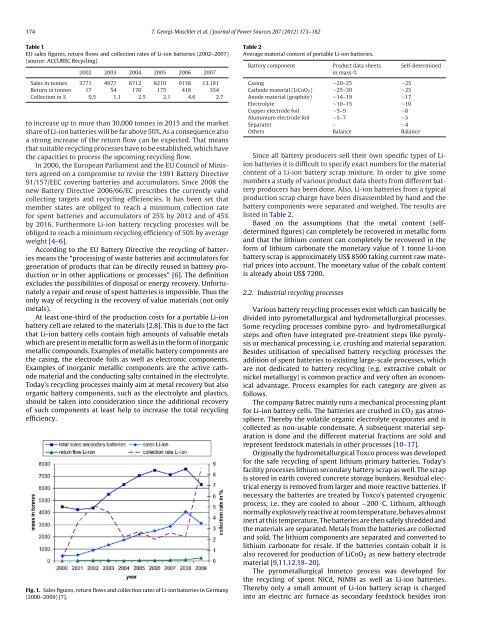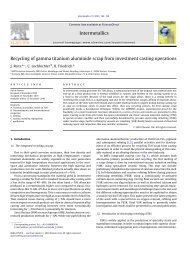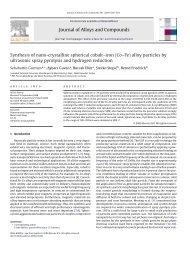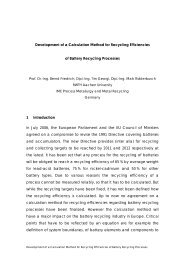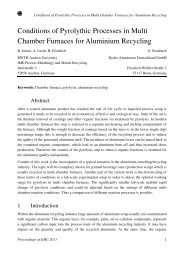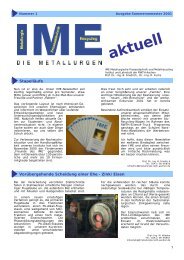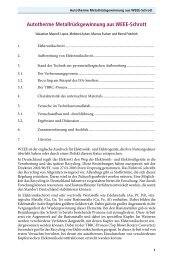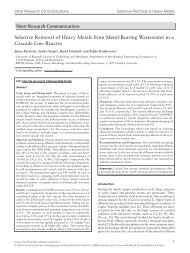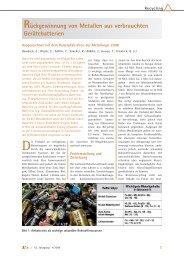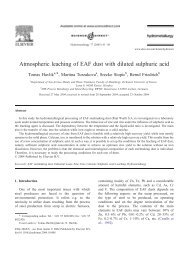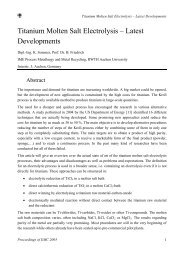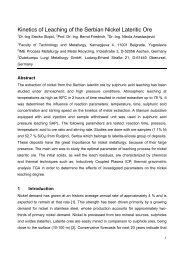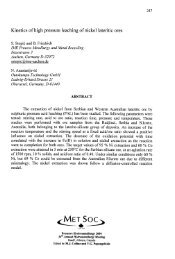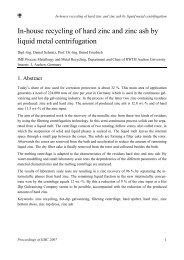Development of a recycling process for Li-ion batteries
Development of a recycling process for Li-ion batteries
Development of a recycling process for Li-ion batteries
- No tags were found...
You also want an ePaper? Increase the reach of your titles
YUMPU automatically turns print PDFs into web optimized ePapers that Google loves.
174 T. Georgi-Maschler et al. / Journal <strong>of</strong> Power Sources 207 (2012) 173–182<br />
Table 1<br />
EU sales figures, return flows and collect<strong>ion</strong> rates <strong>of</strong> <strong>Li</strong>-<strong>ion</strong> <strong>batteries</strong> (2002–2007)<br />
(source: ACCUREC Recycling).<br />
2002 2003 2004 2005 2006 2007<br />
Sales in tonnes 3771 4977 6712 8210 9138 13,181<br />
Return in tonnes 17 54 170 175 418 354<br />
Collect<strong>ion</strong> in % 0.5 1.1 2.5 2.1 4.6 2.7<br />
to increase up to more than 30,000 tonnes in 2015 and the market<br />
share <strong>of</strong> <strong>Li</strong>-<strong>ion</strong> <strong>batteries</strong> will be far above 50%. As a consequence also<br />
a strong increase <strong>of</strong> the return flow can be expected. That means<br />
that suitable <strong>recycling</strong> <strong>process</strong>es have to be established, which have<br />
the capacities to <strong>process</strong> the upcoming <strong>recycling</strong> flow.<br />
In 2006, the European Parliament and the EU Council <strong>of</strong> Ministers<br />
agreed on a compromise to revise the 1991 Battery Directive<br />
91/157/EEC covering <strong>batteries</strong> and accumulators. Since 2008 the<br />
new Battery Directive 2006/66/EC prescribes the currently valid<br />
collecting targets and <strong>recycling</strong> efficiencies. It has been set that<br />
member states are obliged to reach a minimum collect<strong>ion</strong> rate<br />
<strong>for</strong> spent <strong>batteries</strong> and accumulators <strong>of</strong> 25% by 2012 and <strong>of</strong> 45%<br />
by 2016. Furthermore <strong>Li</strong>-<strong>ion</strong> battery <strong>recycling</strong> <strong>process</strong>es will be<br />
obliged to reach a minimum <strong>recycling</strong> efficiency <strong>of</strong> 50% by average<br />
weight [4–6].<br />
According to the EU Battery Directive the <strong>recycling</strong> <strong>of</strong> <strong>batteries</strong><br />
means the “<strong>process</strong>ing <strong>of</strong> waste <strong>batteries</strong> and accumulators <strong>for</strong><br />
generat<strong>ion</strong> <strong>of</strong> products that can be directly reused in battery product<strong>ion</strong><br />
or in other applicat<strong>ion</strong>s or <strong>process</strong>es” [6]. The definit<strong>ion</strong><br />
excludes the possibilities <strong>of</strong> disposal or energy recovery. Un<strong>for</strong>tunately<br />
a repair and reuse <strong>of</strong> spent <strong>batteries</strong> is impossible. Thus the<br />
only way <strong>of</strong> <strong>recycling</strong> is the recovery <strong>of</strong> value materials (not only<br />
metals).<br />
At least one-third <strong>of</strong> the product<strong>ion</strong> costs <strong>for</strong> a portable <strong>Li</strong>-<strong>ion</strong><br />
battery cell are related to the materials [2,8]. This is due to the fact<br />
that <strong>Li</strong>-<strong>ion</strong> battery cells contain high amounts <strong>of</strong> valuable metals<br />
which are present in metallic <strong>for</strong>m as well as in the <strong>for</strong>m <strong>of</strong> inorganic<br />
metallic compounds. Examples <strong>of</strong> metallic battery components are<br />
the casing, the electrode foils as well as electronic components.<br />
Examples <strong>of</strong> inorganic metallic components are the active cathode<br />
material and the conducting salts contained in the electrolyte.<br />
Today’s <strong>recycling</strong> <strong>process</strong>es mainly aim at metal recovery but also<br />
organic battery components, such as the electrolyte and plastics,<br />
should be taken into considerat<strong>ion</strong> since the addit<strong>ion</strong>al recovery<br />
<strong>of</strong> such components at least help to increase the total <strong>recycling</strong><br />
efficiency.<br />
Fig. 1. Sales figures, return flows and collect<strong>ion</strong> rates <strong>of</strong> <strong>Li</strong>-<strong>ion</strong> <strong>batteries</strong> in Germany<br />
(2000–2009) [7].<br />
Table 2<br />
Average material content <strong>of</strong> portable <strong>Li</strong>-<strong>ion</strong> <strong>batteries</strong>.<br />
Battery component Product data sheets Self-determined<br />
in mass-%<br />
Casing ∼20–25 ∼25<br />
Cathode material (<strong>Li</strong>CoO 2) ∼25–30 ∼25<br />
Anode material (graphite) ∼14–19 ∼17<br />
Electrolyte ∼10–15 ∼10<br />
Copper electrode foil ∼5–9 ∼8<br />
Aluminium electrode foil ∼5–7 ∼5<br />
Separator – ∼4<br />
Others Balance Balance<br />
Since all battery producers sell their own specific types <strong>of</strong> <strong>Li</strong><strong>ion</strong><br />
<strong>batteries</strong> it is difficult to specify exact numbers <strong>for</strong> the material<br />
content <strong>of</strong> a <strong>Li</strong>-<strong>ion</strong> battery scrap mixture. In order to give some<br />
numbers a study <strong>of</strong> various product data sheets from different battery<br />
producers has been done. Also, <strong>Li</strong>-<strong>ion</strong> <strong>batteries</strong> from a typical<br />
product<strong>ion</strong> scrap charge have been disassembled by hand and the<br />
battery components were separated and weighed. The results are<br />
listed in Table 2.<br />
Based on the assumpt<strong>ion</strong>s that the metal content (selfdetermined<br />
figures) can completely be recovered in metallic <strong>for</strong>m<br />
and that the lithium content can completely be recovered in the<br />
<strong>for</strong>m <strong>of</strong> lithium carbonate the monetary value <strong>of</strong> 1 tonne <strong>Li</strong>-<strong>ion</strong><br />
battery scrap is approximately US$ 8500 taking current raw material<br />
prices into account. The monetary value <strong>of</strong> the cobalt content<br />
is already about US$ 7200.<br />
2.2. Industrial <strong>recycling</strong> <strong>process</strong>es<br />
Various battery <strong>recycling</strong> <strong>process</strong>es exist which can basically be<br />
divided into pyrometallurgical and hydrometallurgical <strong>process</strong>es.<br />
Some <strong>recycling</strong> <strong>process</strong>es combine pyro- and hydrometallurgical<br />
steps and <strong>of</strong>ten have integrated pre-treatment steps like pyrolysis<br />
or mechanical <strong>process</strong>ing, i.e. crushing and material separat<strong>ion</strong>.<br />
Besides utilisat<strong>ion</strong> <strong>of</strong> specialised battery <strong>recycling</strong> <strong>process</strong>es the<br />
addit<strong>ion</strong> <strong>of</strong> spent <strong>batteries</strong> to existing large-scale <strong>process</strong>es, which<br />
are not dedicated to battery <strong>recycling</strong> (e.g. extractive cobalt or<br />
nickel metallurgy) is common practice and very <strong>of</strong>ten an economical<br />
advantage. Process examples <strong>for</strong> each category are given as<br />
follows.<br />
The company Batrec mainly runs a mechanical <strong>process</strong>ing plant<br />
<strong>for</strong> <strong>Li</strong>-<strong>ion</strong> battery cells. The <strong>batteries</strong> are crushed in CO 2 gas atmosphere.<br />
Thereby the volatile organic electrolyte evaporates and is<br />
collected as non-usable condensate. A subsequent material separat<strong>ion</strong><br />
is done and the different material fract<strong>ion</strong>s are sold and<br />
represent feedstock materials in other <strong>process</strong>es [10–17].<br />
Originally the hydrometallurgical Toxco <strong>process</strong> was developed<br />
<strong>for</strong> the safe <strong>recycling</strong> <strong>of</strong> spent lithium primary <strong>batteries</strong>. Today’s<br />
facility <strong>process</strong>es lithium secondary battery scrap as well. The scrap<br />
is stored in earth covered concrete storage bunkers. Residual electrical<br />
energy is removed from larger and more reactive <strong>batteries</strong>. If<br />
necessary the <strong>batteries</strong> are treated by Toxco’s patented cryogenic<br />
<strong>process</strong>, i.e. they are cooled to about −200 ◦ C. <strong>Li</strong>thium, although<br />
normally explosively reactive at room temperature, behaves almost<br />
inert at this temperature. The <strong>batteries</strong> are then safely shredded and<br />
the materials are separated. Metals from the <strong>batteries</strong> are collected<br />
and sold. The lithium components are separated and converted to<br />
lithium carbonate <strong>for</strong> resale. If the <strong>batteries</strong> contain cobalt it is<br />
also recovered <strong>for</strong> product<strong>ion</strong> <strong>of</strong> <strong>Li</strong>CoO 2 as new battery electrode<br />
material [9,11,12,18–20].<br />
The pyrometallurgical Inmetco <strong>process</strong> was developed <strong>for</strong><br />
the <strong>recycling</strong> <strong>of</strong> spent NiCd, NiMH as well as <strong>Li</strong>-<strong>ion</strong> <strong>batteries</strong>.<br />
Thereby only a small amount <strong>of</strong> <strong>Li</strong>-<strong>ion</strong> battery scrap is charged<br />
into an electric arc furnace as secondary feedstock besides iron


